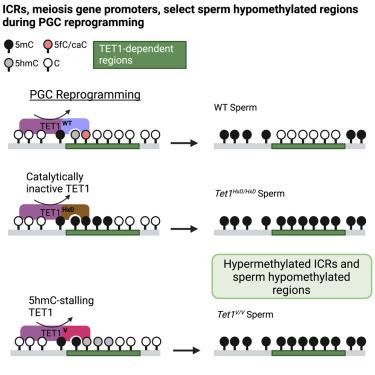Developmental Cell ( IF 11.8 ) Pub Date : 2024-04-02 , DOI: 10.1016/j.devcel.2024.02.012 Rexxi D. Prasasya , Blake A. Caldwell , Zhengfeng Liu , Songze Wu , N. Adrian Leu , Johanna M. Fowler , Steven A. Cincotta , Diana J. Laird , Rahul M. Kohli , Marisa S. Bartolomei

|
Ten-eleven translocation (TET) enzymes iteratively oxidize 5-methylcytosine (5mC) to generate 5-hydroxymethylcytosine (5hmC), 5-formylcytosine, and 5-carboxylcytosine to facilitate active genome demethylation. Whether these bases are required to promote replication-coupled dilution or activate base excision repair during mammalian germline reprogramming remains unresolved due to the inability to decouple TET activities. Here, we generated two mouse lines expressing catalytically inactive TET1 (Tet1-HxD) and TET1 that stalls oxidation at 5hmC (Tet1-V). Tet1 knockout and catalytic mutant primordial germ cells (PGCs) fail to erase methylation at select imprinting control regions and promoters of meiosis-associated genes, validating the requirement for the iterative oxidation of 5mC for complete germline reprogramming. TET1V and TET1HxD rescue most hypermethylation of Tet1−/− sperm, suggesting the role of TET1 beyond its oxidative capability. We additionally identify a broader class of hypermethylated regions in Tet1 mutant mouse sperm that depend on TET oxidation for reprogramming. Our study demonstrates the link between TET1-mediated germline reprogramming and sperm methylome patterning.
中文翻译:

TET1 的迭代氧化对于印记控制区域的重编程和小鼠精子低甲基化区域的图案化是必需的
10-11 易位 (TET) 酶反复氧化 5-甲基胞嘧啶 (5mC),生成 5-羟甲基胞嘧啶 (5hmC)、5-甲酰胞嘧啶和 5-羧基胞嘧啶,以促进活跃的基因组去甲基化。由于无法解耦 TET 活性,这些碱基在哺乳动物种系重编程过程中是否需要促进复制偶联稀释或激活碱基切除修复仍然悬而未决。在这里,我们生成了两个表达催化失活 TET1 ( Tet1-HxD ) 和在 5hmC 时阻止氧化的 TET1 ( Tet1-V )的小鼠品系。Tet1敲除和催化突变原始生殖细胞 (PGC) 无法消除选定印记控制区域和减数分裂相关基因启动子的甲基化,验证了完整种系重编程对 5mC 迭代氧化的要求。 TET1 V和 TET1 HxD挽救了Tet1 −/−精子的大部分高甲基化,这表明 TET1 的作用超出了其氧化能力。我们还在Tet1突变小鼠精子中发现了更广泛的一类高甲基化区域,这些区域依赖于 TET 氧化进行重编程。我们的研究证明了 TET1 介导的种系重编程和精子甲基化模式之间的联系。



























 京公网安备 11010802027423号
京公网安备 11010802027423号